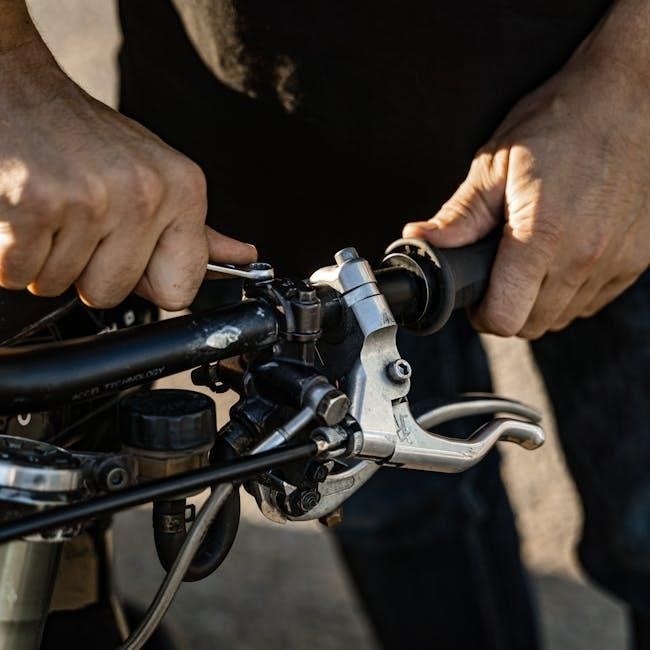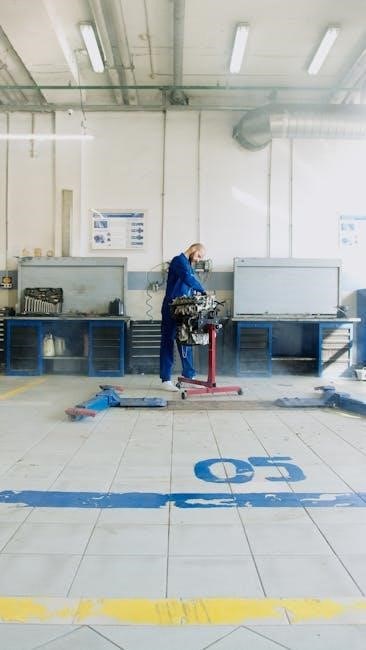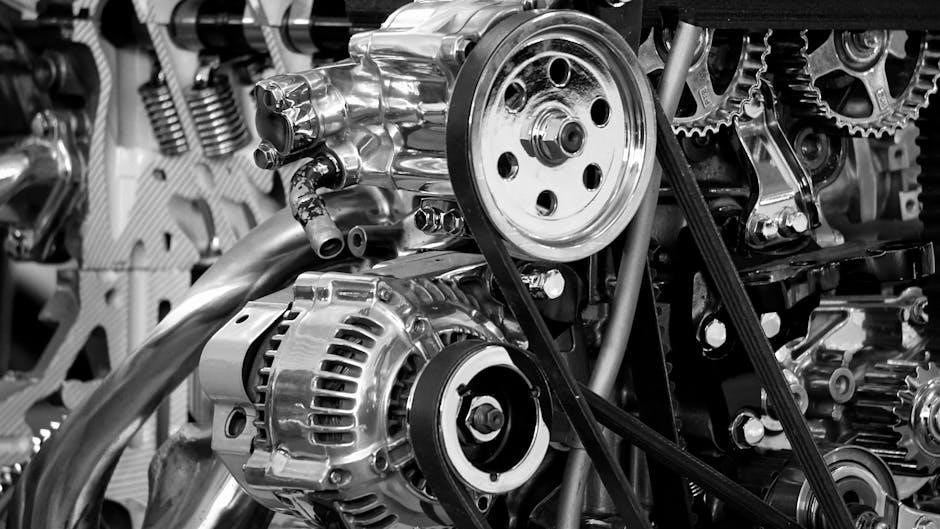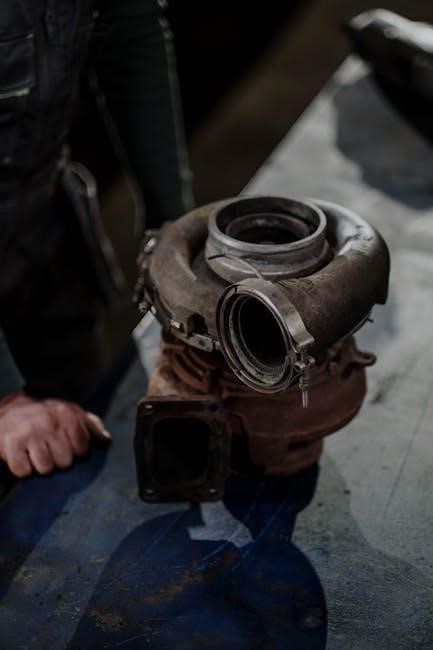Perkins 4-cylinder diesel engines are renowned for their reliability and performance across various industries. Comprehensive manuals, including the Perkins 1100 Series and 1000 Series, provide detailed specifications, repair guidelines, and maintenance schedules, ensuring optimal operation and longevity. These resources are essential for engineers, technicians, and operators seeking to maximize engine efficiency and adhere to manufacturer recommendations.
1.1 Overview of the Perkins 4 Cylinder Diesel Engine
The Perkins 4-cylinder diesel engine is a versatile and reliable power solution, widely used in agricultural, industrial, and automotive applications. Available in various models such as the 1000 Series, 1100 Series, and specific configurations like 4.236 and 4.248, these engines are designed for durability and efficiency. The manuals provide detailed insights into their construction, operation, and maintenance, covering components like cylinder heads, pistons, and fuel systems. Naturally aspirated designs ensure simplicity and robust performance, making them ideal for diverse operational demands. With comprehensive repair guides and troubleshooting tips, these engines are supported by extensive resources for optimal functionality and longevity.
1.2 History and Development of Perkins Engines
Perkins engines have a rich history dating back to the early 20th century, with a focus on innovation and quality. The company, founded by Frank Perkins and Charles Chapman, quickly established itself as a leader in diesel engine technology. Over the years, Perkins has developed a wide range of engines, including the 4-cylinder diesel models, which have become synonymous with reliability and performance. The evolution of these engines reflects advancements in engineering and manufacturing, ensuring they meet the changing needs of various industries. Today, Perkins engines are trusted worldwide for their durability and efficiency, supported by comprehensive manuals and resources.

Key Features and Benefits of the Perkins 4 Cylinder Diesel Engine
The Perkins 4-cylinder diesel engine offers exceptional power, fuel efficiency, and durability. Its compact design, robust construction, and advanced fuel injection system ensure optimal performance across diverse applications.
2.1 Design and Construction Features
The Perkins 4-cylinder diesel engine is built with a robust, compact design, ensuring durability and reliability. Its construction includes a strong cylinder block, forged crankshaft, and high-strength pistons, minimizing wear and tear. The engine features a direct fuel injection system, enhancing combustion efficiency and power output. Additionally, its cooling system is optimized for consistent performance under varying loads. The manual highlights the use of premium materials and precise engineering to ensure long-term reliability. These design elements contribute to reduced emissions and improved fuel efficiency, making it suitable for industrial, agricultural, and automotive applications.
Perkins 4-cylinder diesel engines deliver exceptional performance and efficiency, making them ideal for demanding applications. The engines offer high torque at low speeds, ensuring smooth operation and quick response. Their fuel-efficient design minimizes consumption, reducing operational costs. The manual emphasizes optimized combustion and advanced injection systems, which contribute to superior power output and reduced emissions. These features ensure that the engines meet stringent environmental standards while maintaining reliability. The combination of performance and efficiency makes Perkins 4-cylinder engines a preferred choice for industrial, agricultural, and marine sectors, providing long-term value and operational excellence. Perkins 4-cylinder diesel engines are widely used in diverse industries due to their versatility and reliability. In agriculture, they power tractors and harvesters, ensuring efficient crop management. Industrial applications include generators and heavy machinery, where consistent performance is critical. Automotive sectors utilize these engines in light commercial vehicles, providing a balance of power and fuel efficiency. Marine applications also benefit from their durability and compact design, making them ideal for small vessels. Their adaptability across sectors underscores their reputation as a dependable power solution, tailored to meet the unique demands of each industry while maintaining peak performance and efficiency. The Perkins 4-cylinder diesel engine features a robust design, offering displacements of up to 5.0 liters. It delivers power ratings from 60 to 200 horsepower, with torque outputs tailored for diverse applications. Equipped with advanced fuel injection systems, these engines meet stringent emissions standards while ensuring optimal performance and efficiency. Their adaptability makes them suitable for industrial, agricultural, and automotive use, providing reliable power solutions across various industries. The Perkins 4-cylinder diesel engine is available in both naturally aspirated and turbocharged configurations, offering flexibility for various applications. Displacement ranges from 2.2 to 7.0 liters, ensuring a wide power spectrum. The inline-four design provides a compact and balanced structure, minimizing vibration and enhancing durability. Cylinder bores and strokes are optimized for efficiency, with precise engineering to maximize performance. These configurations cater to diverse needs, from small industrial equipment to heavy-duty machinery, making the engine versatile for multiple industries. Proper configuration selection ensures optimal performance, efficiency, and reliability. The Perkins 4-cylinder diesel engine delivers impressive power and torque across its range, ensuring reliable performance for diverse applications. Power ratings typically range from 50 to 300 horsepower, while torque outputs span from 300 to 1,000 Nm, depending on the specific model and configuration. These ratings are optimized to balance power delivery with fuel efficiency, making the engine suitable for agriculture, construction, and marine applications. The engine’s power and torque are precisely calibrated to meet the demands of heavy-duty operations while maintaining smooth and consistent performance. Always refer to the official manual for exact specifications tailored to your engine model. The Perkins 4-cylinder diesel engine features a advanced fuel system designed for optimal performance and efficiency. Utilizing a common rail fuel injection system, it ensures precise fuel delivery under various operating conditions. High-pressure fuel pumps and electronic control units work together to regulate fuel injection timing and quantity, minimizing emissions and maximizing power output. The system is equipped with fuel filters and water separators to maintain fuel purity and prevent contamination. This technology enhances combustion efficiency, reducing fuel consumption and lowering operational costs. Regular maintenance of the fuel system is essential to sustain its performance and reliability over time. Perkins 4-cylinder diesel engines are designed to meet stringent global emissions standards, ensuring environmental compliance and reduced emissions. These engines comply with EU Stage II, Stage III, and EPA Tier 2/Tier 3 regulations, making them suitable for various industrial and off-highway applications. Advanced emission control technologies, such as Diesel Oxidation Catalysts (DOC) and Diesel Particulate Filters (DPF), are integrated to minimize pollutants like NOx, PM, and CO. The engines also utilize Selective Catalytic Reduction (SCR) systems where required, ensuring adherence to emissions norms while maintaining fuel efficiency and performance. This commitment to environmental responsibility underscores Perkins’ dedication to sustainable engine technology. Proper operation and maintenance ensure optimal performance and longevity of the Perkins 4-cylinder diesel engine. Always follow the manufacturer’s guidelines for pre-start checks, routine servicing, and troubleshooting. Before starting the Perkins 4-cylinder diesel engine, ensure all pre-operation checks are completed. Check fuel and oil levels to avoid shortages during operation. Inspect the coolant level and ensure it’s within the recommended range. Look for any signs of leaks in fuel lines, hoses, or connections. Verify that all electrical connections are secure and free from damage. Wear appropriate safety gear, including gloves and safety glasses, to protect against potential hazards. Ensure the area is well-ventilated to prevent inhaling harmful fumes. Never start the engine with loose clothing or jewelry that could get caught in moving parts. Always refer to the manual for specific guidelines. A routine maintenance schedule is essential for optimal performance of the Perkins 4-cylinder diesel engine. Oil and filter changes should be performed every 50 hours or as specified in the manual. Inspect and replace air filters regularly to ensure proper airflow. Coolant levels should be checked monthly, and the system should be flushed every 2 years. Fuel filters must be replaced every 100 hours to prevent contamination. Inspect belts and hoses for wear and tear, and replace them as needed. Always follow the recommended maintenance intervals to prevent breakdowns and extend engine life. Regular cooling system maintenance is vital for preventing overheating and ensuring reliable operation of the Perkins 4-cylinder diesel engine. Inspect the radiator for dirt, debris, or leaks, and clean it as needed. Check coolant levels regularly and top up with a 50/50 mixture of water and antifreeze. Replace the coolant every 2 years or as specified in the manual. Inspect hoses and connections for signs of wear or damage. Additionally, ensure the water pump is functioning properly. Always use genuine Perkins parts for replacements to maintain system compatibility and performance. Follow the manual for specific maintenance intervals; Proper lubrication is essential for the longevity and performance of the Perkins 4-cylinder diesel engine. Check the engine oil level daily using the dipstick, ensuring it remains within the recommended range. Use a high-quality diesel engine oil that meets Perkins specifications. Change the oil every 250-500 hours of operation, depending on usage conditions. Replace the oil filter with a genuine Perkins filter during each oil change. Drain the old oil responsibly and dispose of it in an environmentally friendly manner. Regular lubrication of moving parts, such as grease points, is also crucial for smooth operation. Always refer to the manual for specific intervals and guidelines. The Perkins 4-cylinder diesel engine’s fuel system ensures efficient combustion. Regular maintenance, including filter replacements and fuel line inspections, is crucial for optimal performance and reliability. The Perkins 4-cylinder diesel engine’s fuel system comprises several critical components. These include the fuel tank, fuel lift pump, fuel filters, fuel injectors, and the fuel injection pump. The fuel tank stores the diesel fuel, while the lift pump creates suction to draw fuel from the tank. Fuel filters ensure clean fuel reaches the engine by removing contaminants. The fuel injectors spray fuel into the combustion chamber under high pressure, controlled by the injection pump. Proper functioning of these components is essential for efficient combustion and engine performance. Regular inspection and maintenance of these parts are vital to prevent fuel system malfunctions. The fuel injection system in a Perkins 4-cylinder diesel engine operates by delivering fuel at high pressure into the combustion chamber at the correct timing. The fuel injection pump, driven by the engine, pressurizes the fuel and meters it according to engine speed and load. The electronic control unit (ECU) regulates injection timing and fuel quantity for optimal performance. Fuel is sprayed through injectors into the cylinders, ensuring efficient combustion. This precise process maximizes power output, reduces emissions, and improves fuel efficiency. Proper synchronization of these components is critical for smooth engine operation and overall performance. Common fuel system issues in Perkins 4-cylinder diesel engines include air in the system, clogged fuel filters, and faulty injectors. Symptoms like hard starting, rough running, or loss of power often indicate a problem. To diagnose, check the fuel filter for blockages and replace it if necessary. Bleed the system to remove air, ensuring proper fuel flow. Inspect fuel lines for leaks or damage and test injector performance. Low fuel pressure or faulty pressure regulators can also cause issues. Addressing these problems promptly prevents engine damage and ensures reliable operation. Always consult the manual for specific troubleshooting procedures. To maximize fuel efficiency in your Perkins 4-cylinder diesel engine, regular maintenance is essential. Ensure air, fuel, and oil filters are clean or replaced as recommended. Check fuel lines for leaks or damage and address them promptly. Maintain proper injector performance by cleaning or replacing them as needed. Keep the cooling system in good condition to prevent overheating, which can reduce efficiency. Regularly inspect and service the fuel pump and pressure regulator. Always use the correct grade of diesel fuel specified in the manual. Proper engine tuning and timely servicing can significantly enhance fuel economy and overall performance. The Perkins 4-cylinder diesel engine features a robust electrical system, including a high-capacity battery, alternator, and wiring harness. Essential components like the starter motor and circuits ensure reliable engine operation. The Perkins 4-cylinder diesel engine’s electrical system is designed for reliability and efficiency. It includes a heavy-duty battery, high-output alternator, and a durable wiring harness. The system powers essential components like the starter motor, fuel injection system, and engine control unit. Advanced circuit protection ensures safety and prevents damage from overloads or short circuits. The electrical system is integrated with other engine systems, such as fuel injection and diagnostics, to optimize performance and monitoring. Regular maintenance, as outlined in the manual, ensures consistent operation and prevents electrical failures. This robust system supports both on-road and off-road applications. The Perkins 4-cylinder diesel engine’s battery and charging system are crucial for reliable starting and electrical power. Heavy-duty batteries are recommended to handle the engine’s high compression requirements. The charging system features a high-output alternator designed to efficiently recharge the battery and support electrical loads while the engine operates. Proper maintenance involves regular checks of battery terminals, ensuring correct charging voltages, and avoiding deep discharges. Always use genuine or compatible parts to maintain system reliability and performance. Regular inspections and adherence to the manual’s guidelines ensure consistent operation, prevent electrical failures, and extend the system’s lifespan. The Perkins 4-cylinder diesel engine features a robust alternator and voltage regulation system to ensure stable electrical power supply. The alternator is designed to charge the battery and power electrical systems efficiently, even under heavy loads. A built-in voltage regulator maintains consistent output, typically between 13.5V to 14.5V, to prevent overcharging and protect electrical components. Regular inspection of the alternator belt and connections is essential for optimal performance. Proper alignment and tension of the belt ensure reliable operation, while periodic testing of voltage output helps identify potential issues early. This system is critical for maintaining engine reliability and electrical system health. Diagnosing electrical system issues in the Perkins 4-cylinder diesel engine requires a systematic approach. Start by checking the battery voltage using a multimeter to ensure it is within the recommended range. Inspect all wiring and connections for signs of wear or corrosion. Use the engine’s diagnostic scanner to identify fault codes, which can pinpoint issues like faulty sensors or relays. Test the alternator output to confirm it is charging correctly. Refer to the manual for specific troubleshooting procedures and wiring diagrams. Regular diagnostics help prevent electrical failures and ensure reliable engine operation. Always follow safety guidelines when working with electrical systems. The cooling system ensures optimal engine temperature regulation, preventing overheating. It includes radiators, hoses, and a water pump. Regular coolant checks and flushes are essential. The cooling system is vital for maintaining optimal engine temperature, preventing overheating, and ensuring reliable operation. It protects engine components from thermal damage, enhancing longevity. Proper cooling also improves fuel efficiency and reduces emissions. A well-functioning system prevents premature wear on cylinders, pistons, and valves. Regular maintenance ensures consistent performance, especially in demanding environments. Neglecting the cooling system can lead to engine failure, costly repairs, and downtime. Thus, prioritizing its upkeep is crucial for sustaining the Perkins 4-cylinder diesel engine’s productivity and overall health. The cooling system of the Perkins 4-cylinder diesel engine includes several critical components designed to manage heat effectively. The radiator is central, dissipating heat from the coolant. The water pump circulates coolant through the engine block and cylinder head. Hoses connect these components, ensuring coolant flow. The thermostat regulates engine temperature by controlling coolant circulation. Additionally, the cooling fan enhances heat dissipation, especially at low speeds. Together, these components ensure optimal engine temperature, preventing overheating and maintaining performance. Regular inspection and maintenance of these parts are essential for reliable engine operation. Regular maintenance of the cooling system is crucial for optimal performance. Check coolant levels daily and top up as needed using a 50/50 water-antifreeze mix. Inspect hoses for cracks or leaks and replace them if necessary. Clean the radiator fins and fan regularly to ensure proper airflow. If overheating occurs, check for blockages in the radiator or hoses. Bleed the system to remove airlocks, which can cause inefficient cooling. Replace the thermostat if it fails to open or close properly. Always refer to the Perkins manual for specific guidelines and troubleshooting steps to maintain engine health and prevent damage. Upgrading the cooling system can enhance engine performance and durability. Consider installing a high-performance radiator with improved heat dissipation. Upgraded coolant hoses with reinforced materials can withstand higher pressures and temperatures. A high-capacity water pump ensures consistent coolant circulation. Additionally, aftermarket cooling fans with better airflow can improve efficiency. When upgrading, ensure all components are compatible with your Perkins engine. Always follow the manual’s guidelines for installation and compatibility. Professional installation is recommended to avoid system malfunctions. Regularly review the manual for upgrade options tailored to your engine model and operational demands. Troubleshooting common issues in your Perkins 4-cylinder diesel engine involves identifying problems early, using diagnostic tools, and consulting the manual for repair guidance. Act promptly to prevent damage. Identifying and diagnosing common problems in a Perkins 4-cylinder diesel engine begins with recognizing symptoms like unusual noises, warning lights, or reduced performance. Always refer to the manual for specific guidance. Use diagnostic tools to pinpoint issues such as fault codes or sensor malfunctions. Regularly inspect fuel, oil, and coolant levels, as low levels often trigger problems. Look for signs of wear or leaks in key components like fuel injectors or hoses. Early detection prevents minor issues from escalating into major repairs. Consult the manual’s troubleshooting section for step-by-step solutions tailored to your engine model. Addressing engine overheating in a Perkins 4-cylinder diesel engine involves identifying the root cause. Start by checking coolant levels and ensuring proper coolant circulation. Inspect the radiator for blockages or damage and clean or replace it if necessary. Verify that the water pump is functioning correctly and replace it if faulty. Check the thermostat for proper operation and ensure the cooling fan is working as intended. Avoid overheating by maintaining the recommended coolant-to-water ratio and ensuring good airflow around the engine compartment. Refer to the manual for specific procedures to resolve overheating issues effectively and prevent engine damage. Low power output in a Perkins 4-cylinder diesel engine can result from various factors. Check the fuel system for dirty or clogged fuel filters and ensure proper fuel flow. Inspect the air filter for cleanliness and replace it if necessary to maintain adequate airflow. Verify the condition of the turbocharger, as damage or blockages can significantly reduce power. Additionally, check the exhaust system for restrictions or leaks. Regular servicing, including compression tests and injection system checks, can help identify and resolve issues. Always consult the manual for specific diagnostic procedures and adjustments to restore optimal performance. Resolving fuel system malfunctions in a Perkins 4-cylinder diesel engine involves identifying and addressing issues promptly. Common problems include fuel contamination, clogged fuel filters, or faulty fuel injectors. Begin by inspecting the fuel tank for dirt or water and draining it if necessary. Replace the fuel filters and check the fuel lines for blockages or leaks. Ensure the fuel injection system is clean and functioning properly, as dirty or worn injectors can disrupt fuel flow. Additionally, check the fuel pump for low pressure or failure. Regular maintenance, such as filter replacements and system bleeding, can prevent malfunctions and ensure reliable engine performance. Explore a wide range of genuine and aftermarket parts, essential tools, and accessories designed to maintain, repair, and enhance the performance of Perkins 4-cylinder engines. When maintaining or repairing a Perkins 4-cylinder diesel engine, choosing between genuine and aftermarket parts is crucial. Genuine parts are manufactured by Perkins, ensuring precise fitment, reliability, and compliance with original specifications. They often come with warranties and are recommended for maintaining engine performance and longevity. Aftermarket parts, while cost-effective, may vary in quality and compatibility. They can be a budget-friendly option but may lack the same level of testing and certification as genuine components. Always verify the manufacturer’s reputation and specifications to ensure optimal performance and durability for your engine. Maintaining and repairing a Perkins 4-cylinder diesel engine requires a set of essential tools to ensure efficiency and safety. Basic tools include wrenches, screwdrivers, pliers, and sockets. Specialized tools like a torque wrench, compression tester, and fuel injection testers are also necessary for specific tasks. Diagnostic tools, such as multimeters and scan tools, help identify issues. Always use high-quality tools that meet the specifications outlined in the manual. Proper tools prevent damage to engine components and ensure accurate repairs, adhering to safety and performance standards. Regularly inspect and maintain tools to keep them in good working condition. Reliable parts for the Perkins 4-cylinder diesel engine can be sourced from authorized Perkins dealers, ensuring genuine components. Independent suppliers and online retailers may also offer high-quality alternatives. Always verify the authenticity of parts by checking for Perkins branding, serial numbers, or certifications. Purchasing from reputable sources guarantees compatibility and performance. Additionally, consider contacting engine rebuild specialists or local distributors for hard-to-find components. Warranties and return policies are essential safeguards when buying parts. Prioritize suppliers with good customer reviews and technical support to ensure long-term engine reliability and performance. To optimize your Perkins 4-cylinder diesel engine, consider high-performance accessories like upgraded air filters for improved airflow and fuel efficiency. Performance exhaust systems can reduce backpressure, enhancing power output. Electronic control unit (ECU) tuning kits are another option, allowing precise calibration for increased torque and horsepower. Additionally, aftermarket turbochargers or intercoolers can boost performance under heavy loads. Always consult the manual or a certified technician to ensure compatibility and avoid voiding warranties. These accessories can significantly enhance engine performance and reliability, especially in demanding industrial or agricultural applications.2.2 Performance and Efficiency Benefits
2.3 Applications in Various Industries

Technical Specifications of the Perkins 4 Cylinder Diesel Engine
3.1 Engine Configuration and Displacement
3.2 Power and Torque Ratings
3.3 Fuel System and Injection Technology
3.4 Emissions Standards and Compliance

Operation and Maintenance Guidelines
4.1 Pre-Operation Checks and Safety Precautions
4.2 Routine Maintenance Schedule
4.3 Cooling System Maintenance
4.4 Lubrication and Oil Change Procedures

Fuel System Overview and Maintenance
5.1 Components of the Fuel System
5.2 Fuel Injection System Operation
5.3 Troubleshooting Fuel System Issues
5.4 Maintenance Tips for Optimal Fuel Efficiency

Electrical System and Components
6.1 Overview of the Electrical System
6.2 Battery and Charging System
6.3 Alternator and Voltage Regulation
6.4 Electrical System Diagnostics

Cooling System Function and Maintenance
7.1 Importance of the Cooling System
7.2 Components of the Cooling System
7.3 Maintenance and Troubleshooting Tips
7.4 Upgrading the Cooling System

Troubleshooting Common Issues
8.1 Identifying and Diagnosing Common Problems
8.2 Solutions for Engine Overheating
8.3 Addressing Low Power Output Issues
8.4 Resolving Fuel System Malfunctions

Parts and Accessories for Perkins 4 Cylinder Engines
9.1 Genuine vs. Aftermarket Parts

9.2 Essential Tools for Maintenance and Repair
9.3 Where to Source Reliable Parts
9.4 Accessories to Enhance Performance
